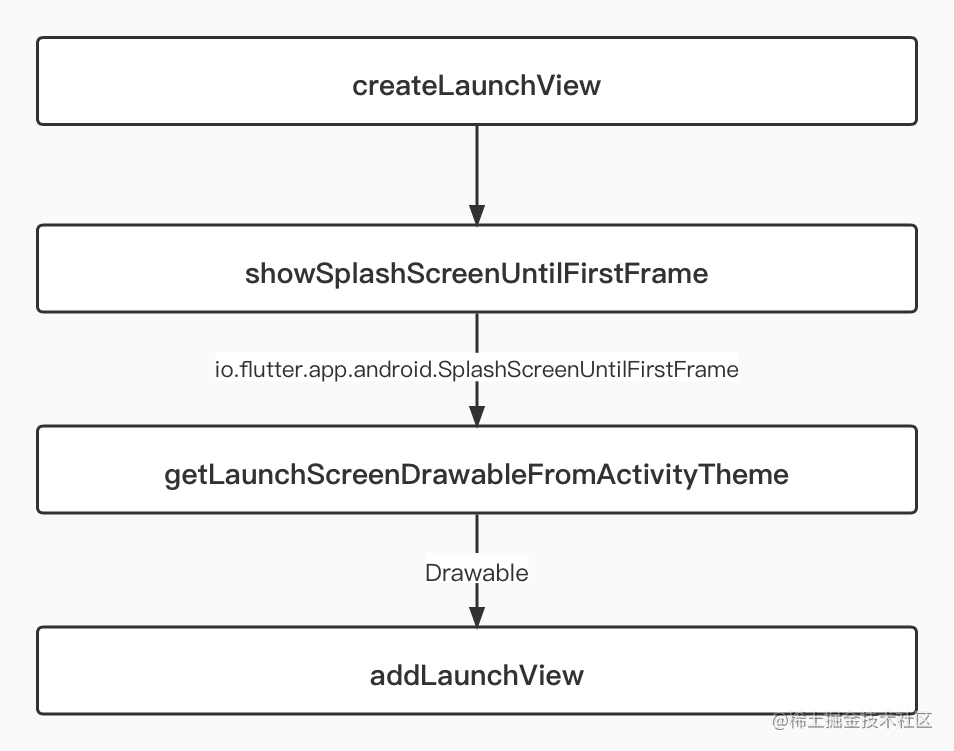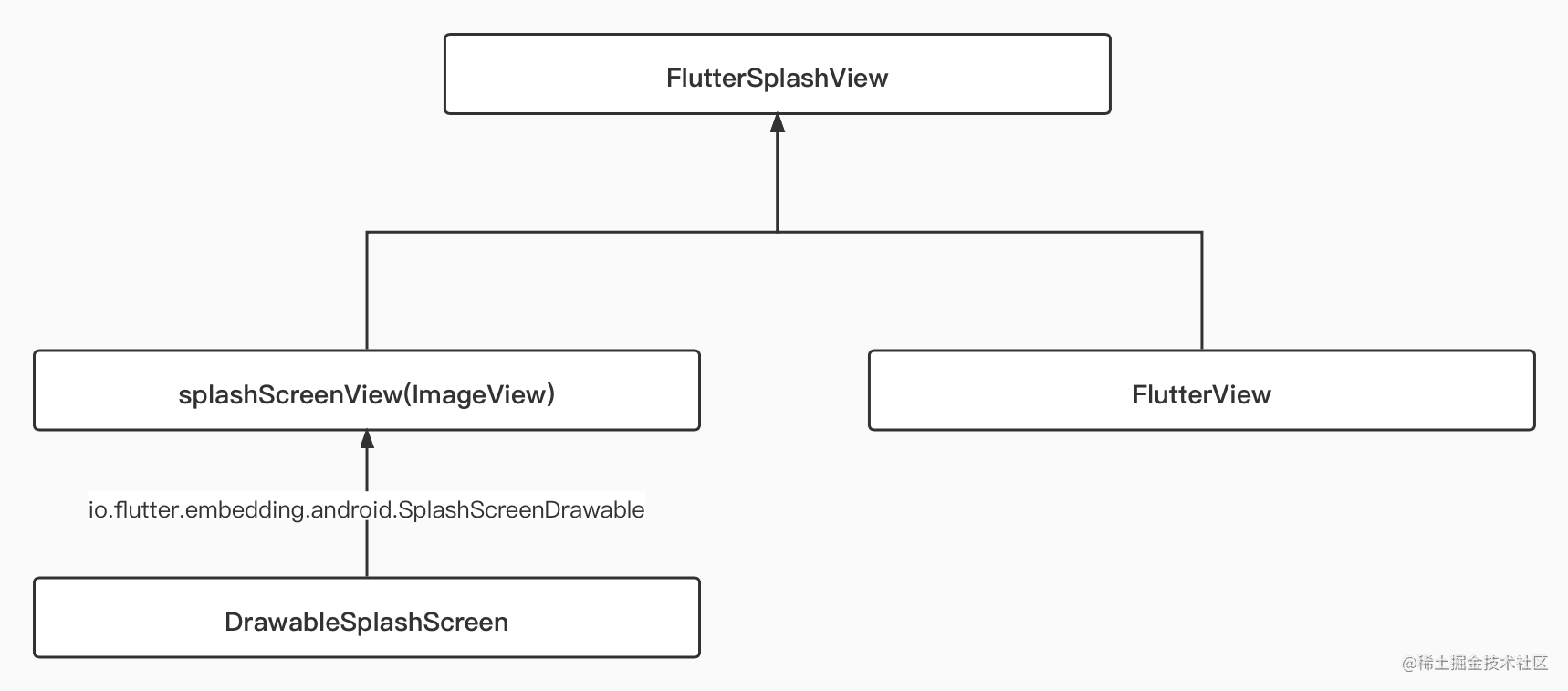APP 启动页在国内是最常见也是必备的场景,其中启动页在 iOS 上算是强制性的要求,其实配置启动页挺简单,因为在 Flutter 里现在只需要:
- iOS 配置 `LaunchScreen.storyboard`;
- Android 配置 `windowBackground`;
一般只要配置无误并且图片尺寸匹配,基本上就不会有什么问题,**那既然这样,还有什么需要适配的呢?**
事实上大部分时候 iOS 是不会有什么问题,**因为 `LaunchScreen.storyboard` 的流程本就是 iOS 官方用来做应用启动的过渡;而对于 Andorid 而言,直到 12 之前 `windowBackground` 这种其实只能算“民间”野路子**,所以对于 Andorid 来说,这其中就涉及到一个点:
> [Flutter's first frame] + [time needed to jump from raster to main thread and get a next Android vsync] = [Android's first frame].
所以下面主要介绍 Flutter 在 Android 上为了这个启动图做了哪些骚操作~
## 一、远古时期
**在已经忘记版本的“远古时期”**, `FlutterActivity` 还在 `io.flutter.app.FlutterActivity` 路径下的时候,那时启动页的逻辑相对简单,主要是通过 App 的 `AndroidManifest` 文件里是否配置了 `SplashScreenUntilFirstFrame` 来进行判断。
```xml
```
**在 `FlutterActivity` 内部 `FlutterView` 被创建的时候,会通过读取 `meta-data` 来判断是否需要使用 `createLaunchView` 逻辑**:
- 1、获取当前主题的 `android.R.attr.windowBackground` 这个 `Drawable` ;
- 2、创建一个 `LaunchView` 并加载这个 `Drawable`;
- 3、将这个 `LaunchView` 添加到 `Activity` 的 `ContentView`;
- 4、在Flutter `onFirstFrame` 时将这个 `LaunchView` 移除;

```java
private void addLaunchView() {
if (this.launchView != null) {
this.activity.addContentView(this.launchView, matchParent);
this.flutterView.addFirstFrameListener(new FirstFrameListener() {
public void onFirstFrame() {
FlutterActivityDelegate.this.launchView.animate().alpha(0.0F).setListener(new AnimatorListenerAdapter() {
public void onAnimationEnd(Animator animation) {
((ViewGroup)FlutterActivityDelegate.this.launchView.getParent()).removeView(FlutterActivityDelegate.this.launchView);
FlutterActivityDelegate.this.launchView = null;
}
});
FlutterActivityDelegate.this.flutterView.removeFirstFrameListener(this);
}
});
this.activity.setTheme(16973833);
}
}
```
是不是很简单,那就会有人疑问为什么要这样做?我直接配置 `Activity` 的 `android:windowBackground` 不就完成了吗?
这就是上面提到的时间差问题,**因为启动页到 Flutter 渲染完第一帧画面中间,会出现概率出现黑屏的情况,所以才需要这个行为来实现过渡**。
## 2.5 之前
经历了“远古时代”之后,`FlutterActivity` 来到了 `io.flutter.embedding.android.FlutterActivity`, 在到 2.5 版本发布之前,Flutter 又针对这个启动过程做了不少调整和优化,其中主要就是 `SplashScreen`。
自从开始进入`embedding` 阶段后,`FlutterActivity` 主要用于实现了一个叫 `Host` 的 `interface`,其中和我们有关系的就是 `provideSplashScreen`。
**默认情况下它会从 `AndroidManifest` 文件里是否配置了 `SplashScreenDrawable` 来进行判断**。
```xml
```
默认情况下当 AndroidManifest 文件里配置了 `SplashScreenDrawable`,那么这个 Drawable 就会在 `FlutterActivity` 创建 `FlutterView` 时被构建成 `DrawableSplashScreen`。

`DrawableSplashScreen` 其实就是一个实现了 `io.flutter.embedding.android.SplashScreen` 接口的类,它的作用就是:
> 在 Activity 创建 FlutterView 的时候,将 `AndroidManifest` 里配置的 `SplashScreenDrawable` 加载成 `splashScreenView`(ImageView);,并提供 `transitionToFlutter` 方法用于执行。
之后 `FlutterActivity` 内会创建出 `FlutterSplashView`,它是个 FrameLayout。
`FlutterSplashView` 将 `FlutterView` 和 `ImageView` 添加到一起, 然后通过 `transitionToFlutter` 的方法来执行动画,最后动画结束时通过 `onTransitionComplete` 移除 `splashScreenView` 。
所以整体逻辑就是:
- 根据 meta 创建 `DrawableSplashScreen` ;
- `FlutterSplashView` 先添加了 `FlutterView` ;
- `FlutterSplashView` 先添加了 `splashScreenView` 这个 ImageView;
- 最后在 `addOnFirstFrameRenderedListener` 回调里执行 `transitionToFlutter` 去触发 animate ,并且移除 `splashScreenView`。
当然这里也是分状态:
- 等引擎加载完成之后再执行 `transitionToFlutter`;
- 引擎已经加载完成了马上执行 `transitionToFlutter`;
- 当前的 `FlutterView` 还没有被添加到引擎,等待添加到引擎之后再 `transitionToFlutter`;
```java
public void displayFlutterViewWithSplash(@NonNull FlutterView flutterView, @Nullable SplashScreen splashScreen) {
if (this.flutterView != null) {
this.flutterView.removeOnFirstFrameRenderedListener(this.flutterUiDisplayListener);
this.removeView(this.flutterView);
}
if (this.splashScreenView != null) {
this.removeView(this.splashScreenView);
}
this.flutterView = flutterView;
this.addView(flutterView);
this.splashScreen = splashScreen;
if (splashScreen != null) {
if (this.isSplashScreenNeededNow()) {
Log.v(TAG, "Showing splash screen UI.");
this.splashScreenView = splashScreen.createSplashView(this.getContext(), this.splashScreenState);
this.addView(this.splashScreenView);
flutterView.addOnFirstFrameRenderedListener(this.flutterUiDisplayListener);
} else if (this.isSplashScreenTransitionNeededNow()) {
Log.v(TAG, "Showing an immediate splash transition to Flutter due to previously interrupted transition.");
this.splashScreenView = splashScreen.createSplashView(this.getContext(), this.splashScreenState);
this.addView(this.splashScreenView);
this.transitionToFlutter();
} else if (!flutterView.isAttachedToFlutterEngine()) {
Log.v(TAG, "FlutterView is not yet attached to a FlutterEngine. Showing nothing until a FlutterEngine is attached.");
flutterView.addFlutterEngineAttachmentListener(this.flutterEngineAttachmentListener);
}
}
}
private boolean isSplashScreenNeededNow() {
return this.flutterView != null && this.flutterView.isAttachedToFlutterEngine() && !this.flutterView.hasRenderedFirstFrame() && !this.hasSplashCompleted();
}
private boolean isSplashScreenTransitionNeededNow() {
return this.flutterView != null && this.flutterView.isAttachedToFlutterEngine() && this.splashScreen != null && this.splashScreen.doesSplashViewRememberItsTransition() && this.wasPreviousSplashTransitionInterrupted();
}
```
**当然这个阶段的 FlutterActivity 也可以通过 `override` `provideSplashScreen` 方法来自定义 SplashScreen**。
> 注意这里的 SplashScreen 不等于 Android 12 的 SplashScreen。
看到没有,做了这么多其实也就是为了弥补启动页和 Flutter 渲染之间,**另外还有一个优化,叫 `NormalTheme`**。
> 当我们设置了一个 `Activity` 的 `windowBackground` 之后,其实对性能还是多多少少会有影响,所以官方就增加了一个 `NormalTheme` 的配置,**在启动完成之后将主题设置为开发者自己配置的 `NormalTheme`**。
通过该配置 `NormalTheme` ,在 `Activity` 启动时,就会首先执行 `switchLaunchThemeForNormalTheme();` 方法将主题从 `LaunchTheme` 切换到 `NormalTheme`。
```xml
```
大概配置完就是如下样子,**前面分析那么多其实就是为了告诉你,如果出现问题了,你可以从哪个地方去找到对应的点**。
```xml
```
## 2.5 之后
讲了那么多,**Flutter 2.5 之后 `provideSplashScreen` 和 `io.flutter.embedding.android.SplashScreenDrawable` 就被弃用了,惊不喜惊喜,意不意外,开不开心** ?
> Flutter 官方说: Flutter 现在会自动维持着 Android 启动页面的效显示,直到 Flutter 绘制完第一帧后才消失。
通过源码你会发现,当你设置了 `splashScreen` 的时候,会看到一个 log 警告:
```java
if (splashScreen != null) {
Log.w(
TAG,
"A splash screen was provided to Flutter, but this is deprecated. See"
+ " flutter.dev/go/android-splash-migration for migration steps.");
FlutterSplashView flutterSplashView = new FlutterSplashView(host.getContext());
flutterSplashView.setId(ViewUtils.generateViewId(FLUTTER_SPLASH_VIEW_FALLBACK_ID));
flutterSplashView.displayFlutterViewWithSplash(flutterView, splashScreen);
return flutterSplashView;
}
```
为什么会弃用?
其实这个提议是在 https://github.com/flutter/flutter/issues/85292 这个 issue 上,然后通过 https://github.com/flutter/engine/pull/27645 这个 pr 完成调整。
大概意思就是:**原本的设计搞复杂了,用 `OnPreDrawListener` 更精准,而且不需要为了后面 Andorid12 的启动支持做其他兼容,只需要给 FlutterActivity 等类增加接口开关即可**。
也就是2.5之后 Flutter 使用 [ViewTreeObserver.OnPreDrawListener](https://developer.android.com/reference/android/view/ViewTreeObserver.OnPreDrawListener) 来实现延迟直到加载出 Flutter 的第一帧。
为什么说默认情况?**因为这个行为在 FlutterActivity 里,是在 `getRenderMode() == RenderMode.surface` 才会被调用,而 `RenderMode` 又和 `BackgroundMode` 有关心**。
> 默认情况下 BackgroundMode 就是 `BackgroundMode.opaque` ,所以就是 `RenderMode.surface`
所以在 2.5 版本后, FlutterActivity 内部创建完 FlutterView 后就会执行一个 `delayFirstAndroidViewDraw` 的操作。
```java
private void delayFirstAndroidViewDraw(final FlutterView flutterView) {
if (this.host.getRenderMode() != RenderMode.surface) {
throw new IllegalArgumentException("Cannot delay the first Android view draw when the render mode is not set to derMode.surface`.");
} else {
if (this.activePreDrawListener != null) {
flutterView.getViewTreeObserver().removeOnPreDrawListener(this.activePreDrawListener);
}
this.activePreDrawListener = new OnPreDrawListener() {
public boolean onPreDraw() {
if (FlutterActivityAndFragmentDelegate.this.isFlutterUiDisplayed && terActivityAndFragmentDelegate.this.activePreDrawListener != null) {
flutterView.getViewTreeObserver().removeOnPreDrawListener(this);
FlutterActivityAndFragmentDelegate.this.activePreDrawListener = null;
}
return FlutterActivityAndFragmentDelegate.this.isFlutterUiDisplayed;
}
};
flutterView.getViewTreeObserver().addOnPreDrawListener(this.activePreDrawListener);
}
}
```
**这里主要注意一个参数:`isFlutterUiDisplayed`。**
当 Flutter 被完成展示的时候,`isFlutterUiDisplayed` 就会被设置为 true。
**所以当 Flutter 没有执行完成之前,`FlutterView` 的 `onPreDraw` 就会一直返回 false**,这也是 Flutter 2.5 开始之后适配启动页的新调整。
## 最后
看了这么多,大概可以看到其实开源项目的推进并不是一帆风顺的,没有什么是一开始就是最优解,而是经过多方尝试和交流,才有了现在的版本,事实上开源项目里,类似这样的经历数不胜数:
